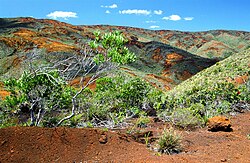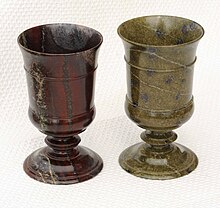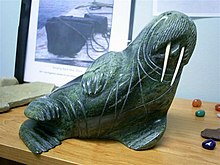User:Kierabiner/sandbox



Serpentinite is a
Formation and petrology
Serpentinization is a form of low-temperature
During serpentinization, large amounts of water are absorbed into the rock, increasing the volume, reducing the density and destroying the original structure.
The final mineral composition of serpentinite is usually dominated by lizardite, chrysotile, and magnetite. Brucite and antigorite are less commonly present. Lizardite, chrysotile, and antigorite all have approximately the formula Mg3(Si2O5)(OH)4 or (Mg2+, Fe2+)3Si2O5(OH)4, but differ in minor components and in form "crystal habit".[16] Accessory minerals, present in small quantities, include awaruite, other native metal minerals, and sulfide minerals.[8]
Formation of serpentine minerals
Olivine is a solid solution of forsterite, the magnesium endmember of (Mg2+, Fe2+)2SiO4, and fayalite, the iron endmember, with forsterite typically making up about 90% of the olivine in ultramafic rocks.[17] Serpentinite can form from olivine via several reactions:
-
+ + 4 H
2O →(Reaction 1a)
-
+ → +(Reaction 1b)
Reaction 1a tightly binds silica, lowering its
A similar suite of reactions involves pyroxene-group minerals:
-
+ + H
2O →(Reaction 2a)
-
+ 3 H
2O → +(Reaction 2b)
Reaction 2a quickly comes to a halt as silica becomes unavailable, and Reaction 2b takes over.[21] When olivine is abundant, silica activity drops low enough that talc begins to react with olivine:
-
+ + →(Reaction 3)
This reaction requires higher temperatures than those at which brucite forms.[20]
The final mineralogy depends both on rock and fluid compositions, temperature, and pressure. Antigorite forms in reactions at temperatures that can exceed 600 °C (1,112 °F) during metamorphism, and it is the serpentine group mineral stable at the highest temperatures. Lizardite and chrysotile can form at low temperatures very near the Earth's surface.[22]
Breakdown of diopside and formation of rodingites
Ultramafic rocks often contain calcium-rich pyroxene (diopside), which breaks down according to the reaction
-
+ 6 H+
→ + 3 Ca2+
+ H
2O +(Reaction 4)
This raises both the pH, often to very high values, and the calcium content of the fluids involved in serpentinization. These fluids are highly reactive and may transport calcium and other elements into surrounding mafic rocks. Fluid reaction with these rocks may create metasomatic reaction zones enriched in calcium and depleted in silica, called rodingites.[23]
Formation of magnetite and hydrogen
In most crustal rock, the chemical activity of oxygen is prevented from dropping to very low values by the
) ions in fayalite. The process is of interest because it generates hydrogen gas:[24][25]
-
+ → + +(Reaction 5)
However, studies of serpentinites suggest that iron minerals are first converted to ferroan brucite, that is, brucite containing Fe(OH)2,[26] which then undergoes the Schikorr reaction in the anaerobic conditions of serpentinization:[27][28]
-
→ + +(Reaction 6)
Maximum reducing conditions, and the maximum rate of production of hydrogen, occur when the temperature of serpentinization is between 200 and 315 °C (392 and 599 °F).[29] If the original ultramafic rock (the protolith) is peridotite, which is rich in olivine, considerable magnetite and hydrogen are produced. When the protolith is pyroxenite, which contains more pyroxene than olivine, iron-rich talc is produced with no magnetite and only modest hydrogen production. Infiltration of silica-bearing fluids during serpentinization can suppress both the formation of brucite and the subsequent production of hydrogen.[30]
Chromite present in the protolith will be altered to chromium-rich magnetite at lower serpentinization temperatures. At higher temperatures, it will be altered to iron-rich chromite (ferrit-chromite).[31] During serpentinization, the rock is enriched in chlorine, boron, fluorine, and sulfur. Sulfur will be reduce to hydrogen sulfide and sulfide minerals, though significant quantities are incorporated into serpentine minerals, and some may later be reoxidized to sulfate minerals such as anhydrite.[13] The sulfides produced include nickel-rich sulfides, such as mackinawite.[32]
Methane and other hydrocarbons
Laboratory experiments have confirmed that at a temperature of 300 °C (572 °F) and pressure of 500 bars, olivine serpentinizes with release of hydrogen gas. In addition, methane and complex hydrocarbons are formed through reduction of carbon dioxide. The process may be catalyzed by magnetite formed during serpentinization.[10] One reaction pathway is:[27]
-
+ + 26 H
2O + CO
2 → + +(Reaction 7)
Metamorphism at higher pressure and temperature
Lizardite and chrysotile are stable at low temperatures and pressures, while antigorite is stable at higher temperatures and pressure. Its presence in a serpentinite indicates either that serpentinization took place at unusually high pressure and temperature or that the rock experienced higher grade metamorphism after serpentinization was complete.[22]
Infiltration of CO2-bearing fluids into serpentinite causes distinctive talc-carbonate alteration. Brucite rapidly converts to magnesite and serpentine minerals (other than antigorite) are converted to talc. The presence of pseudomorphs of the original serpentinite minerals shows that this alteration takes place after serpentinization.[33]
Serpentinite may contain
Above about 450 °C (842 °F), antigorite begins to break down. Thus serpentinite does not exist at higher metamorphic facies.[15]
Extraterrestrial production of methane by serpentinization
The presence of traces of
Using data from the Cassini probe flybys obtained in 2010–12, scientists were able to confirm that Saturn's moon Enceladus likely has a liquid water ocean beneath its frozen surface. A model suggests that the ocean on Enceladus has an alkaline pH of 11–12.[39] The high pH is interpreted to be a key consequence of serpentinization of chondritic rock, that leads to the generation of H
2, a geochemical source of energy that can support both abiotic and biological synthesis of organic molecules.[39][40]
Occurrence

Serpentinite can be formed wherever ultramafic rock is infiltrated by water poor in carbon dioxide.
Conditions are highly favorable for serpentinization at slow to ultraslow spreading mid-ocean ridges.
Serpentinized ultramafic rock is found in many
Serpentinization is nearly total in the forearc mantle of subduction zones. Here mantle rock is cooled by the subducting slab to temperatures at which serpentinite is stable, and fluids are released from the subducting slab in great quantities into the ultramafic mantle rock. Direct evidence that serpentinization is taking place in the Mariana Islands island arc is provided by the activity of serpentinite mud volcanoes. Xenoliths of harzburgite and (less commonly) dunite are occasionally erupted by the mud volcanoes, giving clues to the nature of the protolith.[43]
Because serpentinization increases the volume and lowers the density of the original rock, serpentinitization may lead to uplift that creates coastal ranges above mantle forearcs.[43] Further uplift can bring serpentinite to the surface when subduction ceases, as has taken place with the serpentinite exposed at the Presidio of San Francisco.[44]
Notable occurrences of serpentinite are found at
Hydrothermal vents and mud volcanoes

The formation of serpentinite is highly exothermic, releasing up to 40 kilojoules (9.6 kcal) per mole of water reacting with the rock. This corresponds to a release of about 660 MJ/m3 and can raise the rock temperature by about 260 °C (500 °F),[15] providing an energy source for formation of non-volcanic hydrothermal vents.[14] The hydrogen, methane, and hydrogen sulfide produced during serpentinization are released at these vents and provide energy sources for deep sea chemotroph microorganisms.[15][12]
Deep sea hydrothermal vents located on serpentinite close to the axis of mid-ocean ridges generally resemble
The forearc of the Marianas subduction zone hosts large serpentinite mud volcanoes, which erupt serpentinite mud that rises through faults from the underlying serpentinized forearc mantle. Study of these mud volcanoes gives insights into subduction processes, and the high pH fluids emitted at the volcanoes support a microbial community.[51]
Serpentinite thermal vents are a candidate for the environment in which life on Earth originated.[51] Most of the chemical reactions necessary to synthesize acetyl-CoA, essential to basic biochemical pathways of life, take place during serpentinization.[52] The sulfide-metal clusters that activate many enzymes resemble sulfide minerals formed during serpentinization.[53]
Experimental drilling into the gabbro layer of oceanic crust near mid-ocean ridges has demonstrated the presence of a sparse population of hydrocarbon-degrading bacteria. These may feed on hydrocarbons produced by serpentinization of the underlying ultramafic rock.[54][55]
Ecology

Soil cover over serpentinite bedrock tends to be thin or absent. Soil with serpentine is poor in calcium and other major plant nutrients, but rich in elements toxic to plants such as chromium and nickel.[56] Some species of plants, such as Clarkia franciscana and certain species of manzanita, are adapted to living on serpentinite outcrops. However, because serpentinite outcrops are few and isolated, their plant communities are ecological islands and these distinctive species are often highly endangered.[44] On the other hand, plant communities adapted to living on the serpentine outcrops of New Caledonia resist displacement by introduced species that are poorly adapted to this environment.[57]
Serpentine soils are widely distributed on Earth, in part mirroring the distribution of ophiolites. There are outcroppings of serpentine soils in the Balkan Peninsula, Turkey, the island of Cyprus, the Alps, Cuba, and New Caledonia. In North America, serpentine soils also are present in small but widely distributed areas on the eastern slope of the Appalachian Mountains in the eastern United States, and in the Pacific Ranges of Oregon and California.[citation needed]
Uses
Decorative stone in architecture and art

Serpentine group minerals have a
Carving stone tools, oil lamp-known as the Qulliq and Inuit sculpture
The Inuit and other indigenous people of the Arctic areas and less so of southern areas used the carved bowl shaped serpentinite qulliq or kudlik lamp with wick, to burn oil or fat to heat, make light and cook with. The Inuit made tools and more recently carvings of animals for commerce.[61]
-
Magnetic serpentine walrus
-
Inuit Elder tending the Qulliq, a ceremonial oil lamp made of serpentinite.
Swiss ovenstone
A variety of chlorite talc schist associated with Alpine serpentinite is found in Val d'Anniviers, Switzerland and was used for making "ovenstones" (German: Ofenstein), a carved stone base beneath a cast iron stove.[62]
Neutron shield in nuclear reactors
Serpentinite has a significant amount of
CO2 sequestration
Because it readily absorbs carbon dioxide, serpentinite may be of use for sequestering atmospheric carbon dioxide.[66] To speed the reaction, the serpentinite may be reacted with carbon dioxide at elevated temperature in carbonation reactors. Carbon dioxide may also be reacted with alkaline mine waste from serpentine deposits, or carbon dioxide may be injected directly into underground serpentinite formations.[67] Serpentinite may also be used as a source of magnesium in conjunction with electrolytic cells for CO2 scrubbing.[68]
Cultural references
It is the state rock of California, USA and the California Legislature specified that serpentine was "the official State Rock and lithologic emblem."[4] In 2010, a bill was introduced which would have removed serpentine's special status as state rock due to it potentially containing chrysotile asbestos.[69] The bill met with resistance from some California geologists, who noted that the chrysotile present is not hazardous unless it is mobilized in the air as dust.[70] [needs update]
See also
- Nephrite – Variety of jade
- Soapstone – Talc-bearing metamorphic rock
- Hydrogen cycle – Hydrogen exchange between the living and non-living world
References
- ISBN 9780520295117. Retrieved 6 May 2017.
- ^ "Serpentine definition". Dictionary of Geology. Retrieved 23 October 2018.
- ^ "serpentine". Merriam-Webster.com Dictionary. Merriam-Webster. Retrieved 6 March 2022.
- ^ a b California Government Code § 425.2; see "CA Codes (Gov:420-429.8)". Archived from the original on 28 June 2009. Retrieved 24 December 2009.
- ^ Oakeshott, G.B. (1968). "Diapiric Structures in Diablo Range, California". AAPG Special Volume M8:Diapirism and Diapirs. 153: 228–243.
- .
- S2CID 96761317.
- ^ .
- ^ a b Moody 1976, p. 129.
- ^ .
- ^ Moody 1976, p. 128-129.
- ^ a b c d Serpentinization: The heat engine at Lost City and sponge of the oceanic crust
- ^ .
- ^ .
- ^ ISBN 0-87590-409-2.
- ISBN 978-94-011-3722-5.
- .
- ^ .
- ISBN 978-3540082767.
- ^ a b Moody 1976, p. 127.
- ^ Frost & Beard 2007, p. 1355.
- ^ a b Moody 1976, p. 125, 127, 131.
- ^ Frost & Beard 2007, pp. 1360–1362.
- ^ "Methane and hydrogen formation from rocks – Energy sources for life". Retrieved 6 November 2011.
- PMID 15326313.)
{{cite journal}}: CS1 maint: multiple names: authors list (link - S2CID 55802656.
- ^ S2CID 41118603.
- .
- .
- .
- ^ Moody 1967, p. 128.
- .
- ^ Moody 1976, p. 133.
- ^ Moody 1976, p. 128.
- JSTOR 27858733.
- ^ esa. "The methane mystery". European Space Agency. Retrieved 22 April 2019.
- S2CID 245933224.
- ^ Leah Crane (22 January 2022). "Mars: Organic compounds were made by water interacting with rocks". New Scientist.
- ^ S2CID 119262254.
- ^ Wall, Mike (7 May 2015). "Ocean on Saturn Moon Enceladus May Have Potential Energy Source to Support Life". Space.com. Retrieved 8 May 2015.
- ^ Moody 1976, p. 136.
- ISBN 9780521880060.
- ^ .
- ^ a b "Serpentinite". Presidio of San Francisco. National Park Service. Retrieved 3 September 2021.
- S2CID 3113794.
- S2CID 128410328.
- S2CID 140540631.
- ISBN 0442276249.
- ^ Philpotts & Ague 2009, p. 371.
- .
- ^ PMID 22457979.
- PMID 17255002.
- . Retrieved 5 September 2021.
- PMID 21079766.
- ^ Marshall, Michael (17 November 2010). "Life is found in deepest layer of Earth's crust". New Scientist. Retrieved 3 December 2021.
- ^ "CVO Website - Serpentine and serpentinite" Archived 19 October 2011 at the Wayback Machine, USGS/NPS Geology in the Parks Website, September 2001, accessed 27 February 2011.
- ^ "La flore de Nouvelle-Calédonie – Première partie". Futura-sciences.com. 18 August 2004. Retrieved 30 January 2013.
- ISBN 9780195106916.
- ^ Ashurst, John. Dimes, Francis G. Conservation of building and decorative stone. Elsevier Butterworth-Heinemann, 1990, p. 51.
- ^ Eva Maria Hoyer: Sächsischer Serpentin: ein Stein und seine Verwendung. Edition Leipzig, Leipzig 1996, pp. 20–22.
- ^ Kerr, A.; Squires, G.C. "Serpentinites and associated rock types near Hopedale, Nunatsiavut: Potential for artisanal carving-stone resources" (PDF). Geological Survey Report. 19 (1). Newfoundland and Labrador Department of Natural Resources: 39–57. Retrieved 3 September 2021.
- ^ Talcose-schist from Canton Valais. By Thomags Bonney, (Geol. Mag., 1897, N.S., [iv], 4, 110--116) abstract
- ^ Lithuanian Energy Institute (28 May 2011). "Design of structures, components, equipments and systems". Ignalina Source Book. Archived from the original on 9 October 2011. Retrieved 28 May 2011.
- ^ Aminian, A.; Nematollahi, M.R.; Haddad, K.; Mehdizadeh, S. (3–8 June 2007). Determination of shielding parameters for different types of concretes by Monte Carlo methods (PDF). ICENES 2007: International Conference on Emerging Nuclear Energy Systems. Session 12B: Radiation effects. Istanbul, Turkey. p. 7. Archived from the original (PDF) on 3 March 2016. Retrieved 28 May 2011.
- ISSN 0969-806X.
- S2CID 104424416.
- .
- .
- ^ Fimrite, Peter (16 July 2010). "Geologists protest bill to remove state rock". San Francisco Chronicle. Retrieved 17 April 2018.
- ^ Frazell, Julie; Elkins, Rachel; O'Geen, Anthony; Reynolds, Robert; Meyers, James. "Facts about Serpentine Rock and Soil Containing Asbestos in California" (PDF). ANR Catalog. University of California Division of Agriculture and Natural Resources. Retrieved 17 April 2018.
External links
- [1] The Lost City hydrothermal field, Mid-Atlantic ridge: serpentinization, the driving force of the system.
- H2-rich fluids from serpentinization: Geochemical and biotic implications: Proceedings of the National Academy of Sciences.



